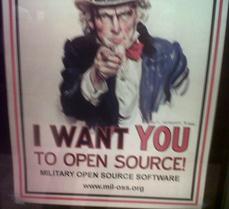Subtitle: Five keys to earn Digital Natives’ trust
This post is #7 in an collaborative eight part series by Brad Szollose and I about how culture shapes technology.
WARNING: These are not universal rules! These are two cultures. What gets high scores for Digital Natives is likely to get you sacked with Digital Immigrants.
How do Digital Natives do business?
 You don’t sell! You collaborate with them to help solve their problems. They’ll discredit everything say if you “go all marketing on them” and try to “sell them.”
You don’t sell! You collaborate with them to help solve their problems. They’ll discredit everything say if you “go all marketing on them” and try to “sell them.”
Here are five ways that you can build a two-way collaborative relationship instead of one-way selling. These tips aren’t speculation: Brad has proven these ideas work in real-world business situations.
Interested in Digital Native Culture? We recommend reading (more books):
1) Share, don’t tell.
Remember the cultural response in Rob’s presentation discussed in the introduction to this paper? The shift took place because Rob wanted to share his expertise instead of selling the awesomeness of his employeer. This is what changed the dynamic.
In a selling situation, the sales pitch doesn’t address our client’s needs. It addresses what we want to tell them and what we think they need. It is a one-way conversation. And if someone has a choice between saying “yes” or “no” in a sales meeting, a client can always have the choice to say “no.”
Sharing draws our customers in so we can hear their problems and solve them. We can also get a barometer on what they know versus what they need. When Rob is presenting to a customer, he’s qualifying the customer too. Solutions are not one size fits all and Digital Natives respect you more for admitting this to them.
Digital Native business is about going for a long-term solution-driven approach instead of just positioning a product. If you’ve collaborated with customers and they agree you’ve got a solution for them then it’s much easier to close the sale. And over the long term, it’s a more lucrative way to do business.
2) Eliminate bottlenecks.
Ten years ago, IT departments were the bottleneck to getting products into the market. If customers resisted, it could take years to get them to like something new. Today, Apple introduces new products every six month with a massive adoption rate because Digital Natives don’t wait for permission from an authority.
The IT buyer has made that sales cycle much more dynamic because our new buyers are Digital Natives. Where Digital Immigrants stayed entrenched in a process or technology, Digital Natives are more willing to try something unproven. Amazon’s EC2 public cloud presented a huge challenge to the authority of IT departments because developers were simply bypassing internal controls. Digital Natives have been trained to look for out-of-the-box solutions to problems.
Time-to-market has become the critical measure for success.
We now have IT end-user buyers who adopt and move faster through the decision process than ever before! We interfere with their decision process if we still treating new buyers as if they can’t keep up and we have to educate them.
Today’s Digital Workers are smart, self-starters who more than understand technology; they live it. Their intuitive nature toward technology and the capacity to use it without much effort has become a cultural skill set. Also they can look up, absorb, and comprehend products without much effort. They did their homework before we walked in the door.
Digital Natives are impatient. They want to skip over what they know and get to real purpose and collaboration. You add bottlenecks when you force them back into a traditional decision process that avoids risk; instead, they are looking to business partners to help them iterate and accelerate.
How did this apply to the Crowbar project?
Crowbar addresses a generation’s impatience to be up and running in record time. But there is more to it than that: we engage with customers differently too. Our open source collaboration and design flexibility mean that we can dialog with customers and partners to figure out the real wants and needs in record time.
3) Let go of linear.
Digital Natives do not want to be walked through detailed linear presentations. They do want the information but leave out the hand holding. The best strategy is to prepare to be a well-trained digital commando—plan a direction, be confident, be ready to respond, and be willing to admit knowledge gaps. It’s a strategy without a strategy.
Ask questions at the beginning of a meeting—this becomes a knowledge base “smell test.” Listening to what our clients know and don’t know gets us to the heart and purpose of why we are there. Take notes. Stay open to curve balls, tough questions, and—dare we say it—the client telling us we are off base. You should not be surprised at how much they know.
For open source projects at Dell (Rob’s Employeer), customers have often downloaded and installed the product before they have talked to the sales team. Rob has had to stop being surprised when they are better informed about our offerings than our well trained internal teams. Digital Natives love collecting information and getting started independently. This completely violates the normal linear sales process; instead, customers enter more engaged and ready if you can be flexible enough to meet them where they already are.
4) Be attentively interactive.
No one likes to sit in one meeting after another. Why are meetings boring? Meetings should be engaging and collaborative; unfortunately, most meetings are simply one-way presentations or status updates. When Digital Natives interrupt a presentation, it may mean they are not getting what they want but it also means they are paying attention.
Aren’t instant messaging, texting, and tweeting attention-stealing distractions?
Don’t confuse IMing, texting, emailing, and tweeting as lack of attention or engagement.
Digital Natives use these “back channels” to speed up knowledge sharing while eliminating the face-to-face meeting inertia of centralized communication.
Of course, sometimes we do check out and stop paying attention.
Time and attention are valuable commodities!
With all the distractions and multi-tasking for speed and connectivity, giving someone undivided attention is about respect, and paying attention is not passive! When we ask questions, it shows that we’re engaged and paying attention. When we compile all the answers from those questions, our intention leads us to solutions. Solving our client’s problems is about getting to the heart of the matter and becomes the driving force behind every action and solution.
Don’t be afraid to stray from the agenda—our attention is the agenda.
5) Stay open to happy accidents.
In Brad’s book, Liquid Leadership, the chapter titled “Have Laptop. Will Travel” points out how Digital Natives have been trained in virtualized work habits because they are more effective.
Our customers are looking for innovative solutions to their problems and may find them in places that we do not expect. It is our job to stay awake and open to solution serendipity. Let’s take this statement out of our vocabulary: “That’s not how we do it.” Let’s try a new approach: “That isn’t traditionally how we would do it, but let us see if it could improve things.”
McDonald’s uses numbers for their combo meals to make sure ordering is predictable and takes no more than 30 seconds. It sounds simple, but changes come from listening to customers’ habits. We need to stop judging and start adapting. Imagine a company that adapts to the needs of its customers?
Sales guru Jeffery Gitomer pays $100 in cash to any one of his employees who makes a mistake. This mistake is analyzed to figure out if it is worthy of application or to be discarded. He doesn’t pay $100 if they make the same mistake twice. Mistakes are where we can discover breakthrough ideas, products, and methods.
Making these kinds of leaps requires that we first let go of rigid rules and opinions and make it OK to make a few mistakes … as long as we look at them through a lens of possibility. Digital Natives have spent 10,000 hours playing learning to make mistakes, take risks, and reach mastery.
Keep Reading! Next post is Three Takeaways (previous Win by Failing)
 2016 is the year we break down the monoliths. We’ve spent a lot of time talking about monolithic applications and microservices; however, there’s an equally deep challenge in ops automation.
2016 is the year we break down the monoliths. We’ve spent a lot of time talking about monolithic applications and microservices; however, there’s an equally deep challenge in ops automation.

 I could not be happier with the results Crowbar collaborators and
I could not be happier with the results Crowbar collaborators and  We’re moving along on the
We’re moving along on the  Nearly a year ago at
Nearly a year ago at 
 Last week,
Last week, 